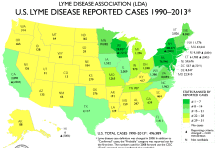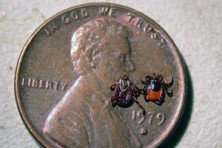Ick… Ticks
- Share
- Tweet
- Pin
- Share
My first tick of the season wasn’t hiding in the woods or crawling on my skin. It was in a jar on the kitchen counter, marked with a yellow sticky note on which my roommate had scrawled Watch For Ticks!
He had found the fat wood tick hitched to his back, and thought the little bugger should serve a life sentence in a Ball jar, where it would slowly suffocate and warn the rest of us to watch for his eight-legged kind. I unmercifully shortened this sentence by giving the jar a few violent shakes with each pass through the house.

A wood tick (left) and deer tick.
Photo by the University of Wisconsin Entomology Department.
The tick soon died, but its memory lives on every time I check my armpits and knees for more blood-sucking hitchhikers. Since that tick was likely only the first of many this summer, let’s take some time to learn more about Door County ticks, how to avoid them and what to do if one finds you.
Know Thy Enemy:
DEER TICK: Deer ticks are small, about the size of a sesame seed, and have reddish-brown bodies and black legs. These ticks transmit Lyme Disease and other diseases, and are also known as blacklegged ticks.
WOOD TICK: Adult wood ticks are larger than deer ticks and change in size based on how much blood they’ve selfishly sucked from you. Adult wood ticks are reddish-brown with silver or white markings, and baby wood ticks are yellowish-gray. Wood ticks have rectangular heads and mouthparts, and are also known as American dog ticks.
BROWN DOG TICK: Brown dog ticks are reddish-brown without any markings, and more often attach to dogs than humans.
How to Avoid Tick Bites:
The best way to avoid tick-borne diseases is to avoid tick bites. Here are some tips:
KNOW WHERE THEY LIVE: Veterinarian Paul King said ticks like to get two or three feet above ground, so they can perch and wait for their next meal (you). They tend to hang out in places with tall weeds or grass near the edges of wooded areas or ponds.
MOW YOUR LAWN: Ticks don’t usually hang out in short grass, so mow your lawn.
WEAR MORE CLOTHES: Seriously. When you’re in tick country, wear long sleeves and tuck your pants into your socks. Don’t give those suckers a chance.
WEAR LIGHT-COLORED CLOTHES: That way you’ll see a tick if it lands on you. (This is why I always hike in my Michelin Man costume.)
USE BUG SPRAY: If you fancy DEET, use it. If you prefer “natural” bug repellent, use that instead.
CHECK YOUR CREVICES: Ticks like warm places, such as your armpits. When you get home from a venture into tick land, give yourself a once-over.
There’s a Tick in My Skin What Do I Do?!
First, don’t panic. Second, go find some tweezers. Use the tweezers to grab the tick near its mouth, as close to the skin as possible. Once you have hold of the monster, pull it upward. Then, disinfect the bite with soap and water, hydrogen peroxide or rubbing alcohol. (While some swear by using matches, petroleum jelly or kerosene to remove ticks, the Center for Disease Control recommends the tweezer method.)
Tick-borne Diseases:
Ticks aren’t just gross little blood suckers, they’re also potential vectors of disease. Lyme Disease, while rare, is the most common tick-borne disease in Door County, according to Sarah Keller, a rheumatologist at Ministry Door County Medical Center.
But don’t worry, you’re not at the mercy of the tick. Ticks have to be attached for at least 48 hours in order to transmit Lyme Disease, so regular tick checks should prevent transmission. Still, be aware of the following symptoms and head straight to a doctor if you develop any: a circular rash near tick bite, or flu-like symptoms such as fever and muscle ache. Lyme Disease is treated with antibiotics.
Other tick-transmitted diseases, such as Babesiosis and Anaplasmosis, are even less common than Lyme Disease. Keller said they are both shown through flu-like symptoms, so if it’s the summertime and you think you have the flu you should go to a doctor.
Protect Your Pets:
Veterinarian Paul King from the Animal Clinic in Sturgeon Bay recommended pet owners, especially dog owners, take the following steps to protect pets from ticks:
• Use a tickicide product such as Frontline Plus regularly
• Avoid areas where ticks often live
• Examine dogs regularly for ticks
• Remove ticks as soon as possible
• Discuss with your veterinarian if your dog should be vaccinated for Lyme Disease
• Watch pets closely for signs of disease: joint pain, fever, lethargy, pale gums and poor appetite
Other Sources: Centers for Disease Control and Prevention, Wisconsin Department of Health Services, University of Wisconsin – Madison Department of Entomology tick website


